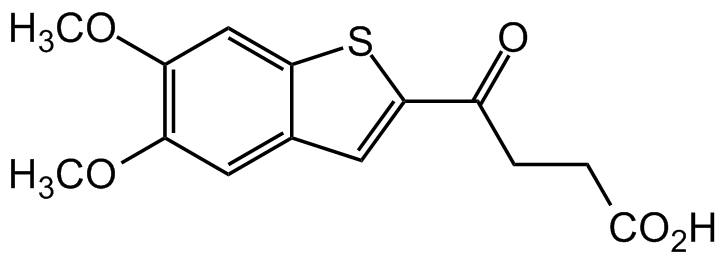
Chemical Structure
MSA-2 [129425-81-6]

AG-CR1-0164
CAS Number129425-81-6
Product group Chemicals
Estimated Purity>98%
Molecular Weight294.3
Overview
- SupplierAdipoGen Life Sciences
- Product NameMSA-2 [129425-81-6]
- Delivery Days Customer10
- CAS Number129425-81-6
- CertificationResearch Use Only
- Estimated Purity>98%
- Molecular FormulaC14H14O5S
- Molecular Weight294.3
- Scientific DescriptionChemical. CAS: 129425-81-6. Formula: C14H14O5S. MW: 294.3. MSA-2 is a new orally available non-nucleotide STING (STimulator of INterferon Genes) agonist, with EC50s of 8.3 and 24microM for human STING isoforms WT and HAQ. Activation of the STING protein by its natural ligand, cyclic guanosine monophosphate-adenosine monophosphate (cGAMP, a cytosolic double-stranded DNA sensor), triggers signaling responses, inducing the release of type I interferons and other proinflammatory cytokines. STING-controlled interferon production is involved in antiviral defense as well as antitumor immunity. Pharmacological activation of STING is considered a promising therapeutic strategy for cancer. MSA-2 highly induces secretion in vitro of IFN-beta from THP-1 cells and mouse macrophages at concentration of 10-50microM. It shows in vivo antitumor activity in a MC38 mouse model of colon carcinoma in a dose-dependent manner, stimulating IFN-beta secretion in tumors, inducing tumor regression with durable antitumor immunity when administered intratumorally (450microg), subcutaneously (50mg/kg) or orally (50mg/kg), and synergizes with anti-PD-1 therapy. MSA-2 is a small molecule monomer that undergoes reversible, noncovalent dimerization in solution to become a pharmacologically active ligand. MSA-2 monomers cannot bind STING, whereas the noncovalent MSA-2 dimers bind STING with nanomolar affinity. MSA-2, a weak acid, exhibits substantially higher cellular potency in an acidified tumor microenvironment (versus normal tissue), owing to increased cellular entry and retention combined with its inherent mode of interaction with STING. - MSA-2 is a new orally available (cell permeable) non-nucleotide STING (STimulator of INterferon Genes) agonist, with EC50s of 8.3 and 24microM for human STING isoforms WT and HAQ. Activation of the STING protein by its natural ligand, cyclic guanosine monophosphate-adenosine monophosphate (cGAMP, a cytosolic double-stranded DNA sensor), triggers signaling responses, inducing the release of type I interferons and other proinflammatory cytokines. STING-controlled interferon production is involved in antiviral defense as well as antitumor immunity. Pharmacological activation of STING is considered a promising therapeutic strategy for cancer. MSA-2 highly induces secretion in vitro of IFN-beta from THP-1 cells and mouse macrophages at concentration of 10-50microM. It shows in vivo antitumor activity in a MC38 mouse model of colon carcinoma in a dose-dependent manner, stimulating IFN-beta secretion in tumors, inducing tumor regression with durable antitumor immunity when administered intratumorally (450microg), subcutaneously (50mg/kg) or orally (50mg/kg), and synergizes with anti-PD-1 therapy. MSA-2 is a small molecule monomer that undergoes reversible, noncovalent dimerization in solution to become a pharmacologically active ligand. MSA-2 monomers cannot bind STING, whereas the noncovalent MSA-2 dimers bind STING with nanomolar affinity. MSA-2, a weak acid, exhibits substantially higher cellular potency in an acidified tumor microenvironment (versus normal tissue), owing to increased cellular entry and retention combined with its inherent mode of interaction with STING.
- SMILESO=C(CCC(O)=O)C1=CC2=CC(OC)=C(OC)C=C2S1
- Storage Instruction-20°C,2°C to 8°C
- UNSPSC12352200
